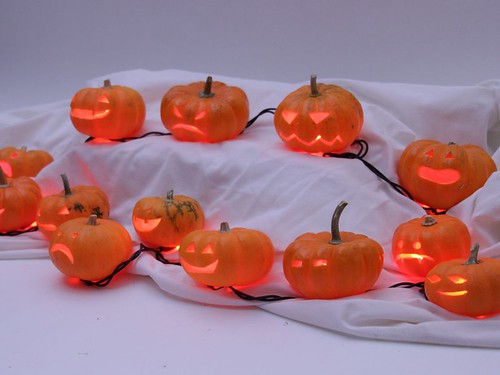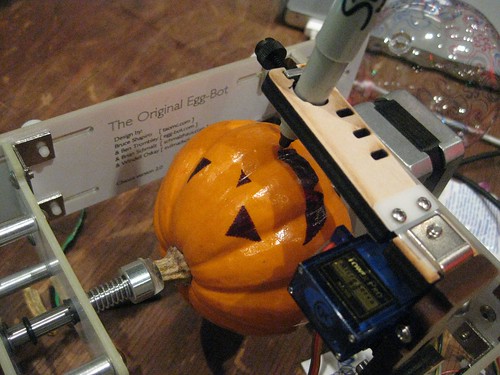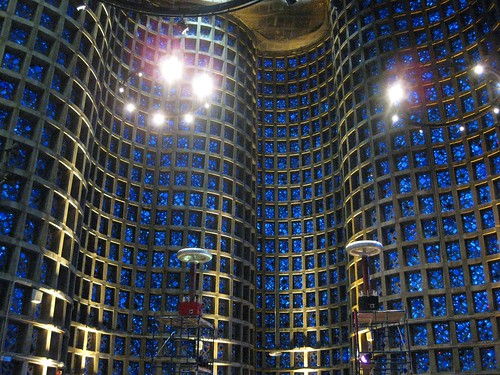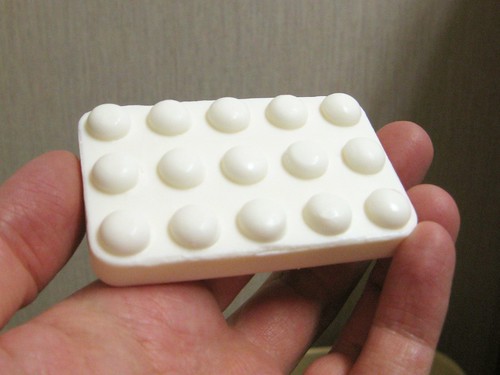All posts by Windell Oskay
MeggyCade Jr
From our forums comes this awesome “MeggyCade Jr” by Michale Molero:
“The MeggyCade is the first (and currently only) tabletop arcade game that includes a full-featured Meggy Jr RGB game system inside it, complete with authentic arcade controls. I built this thing from scratch in just under a month (with spurts of free time here and there).”
The video demo is at Youtube, and there’s a photo build log up here. Nice work!
Making classic frequency counters into Nixie clocks
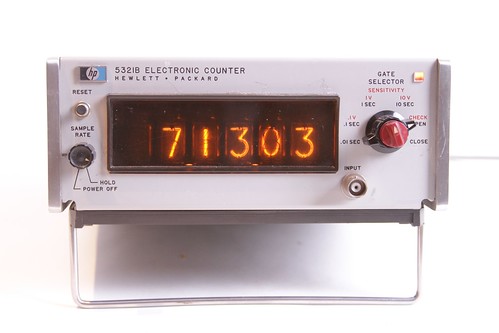
One of our favorite longstanding projects– which we dropped a hint about some time ago –is converting old HP Nixie-tube counters into happily glowing Nixie clocks. Here’s how we do it.
Continue reading Making classic frequency counters into Nixie clocks
Your own private mini-pumpkin jack O’lantern army
One of our favorite low tech halloween decorations is a (tiny) army of mini jack o’lanterns. Here’s how to carve your own. Continue reading Your own private mini-pumpkin jack O’lantern army
A pumpkin that sleeps like a Mac
Here’s an neat idea for a jack-o’-lantern: Hide a single white LED just beneath the thin surface of the pumpkin. And program it with the same slow “breathing” effect that indicates sleep on Mac computers.
The result? A pumpkin that sleeps like a Mac. It’s actually quite striking, in part because the effect becomes invisible every few seconds. It’s also an easy microcontroller project: our demonstration video and build instructions follow. Continue reading A pumpkin that sleeps like a Mac
Printing on a strangely shaped egg
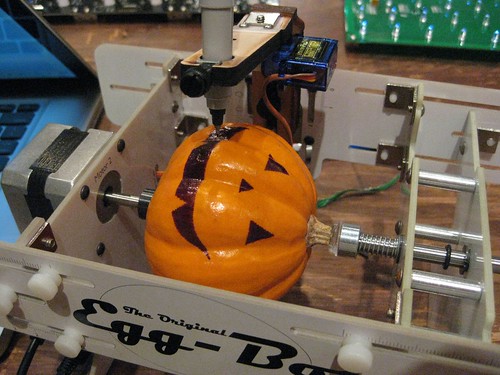
 One of those questions that keeps coming up about the Egg-Bot is, “Does the surface have to be perfectly smooth?” Or sometimes just, “Can you print on a golf ball?”
While we wouldn’t go so far as to say that you’ll have good luck printing on a tennis ball, it turns out that the surface doesn’t exactly have to be flat either. Golf balls certainly aren’t a challenge. And, as you can see above, you can even plot on strangely shaped “eggs,” so long as the surface is smooth enough that you can drag a marker along. Neat.
Update: We’ve posted some tips on using the Eggbot with pumpkins here.
One of those questions that keeps coming up about the Egg-Bot is, “Does the surface have to be perfectly smooth?” Or sometimes just, “Can you print on a golf ball?”
While we wouldn’t go so far as to say that you’ll have good luck printing on a tennis ball, it turns out that the surface doesn’t exactly have to be flat either. Golf balls certainly aren’t a challenge. And, as you can see above, you can even plot on strangely shaped “eggs,” so long as the surface is smooth enough that you can drag a marker along. Neat.
Update: We’ve posted some tips on using the Eggbot with pumpkins here.
You can find more pumpkin projects in our Halloween Project Archive.
MUNI time lapse video
Church and 30th St. San Francisco MUNI Construction from Ken Murphy on Vimeo.
Our friend Ken Murphy of Blinky Bug and History of the Sky fame just posted this incredible time lapse movie, watching as construction workers replaced San Francisco metro train tracks outside of his apartment. The work was done from October 8-12, and the movie spans 12 minutes. It’s amazing how much goes into something that looks so simple.Bottles of Hope Chandelier

Bottles Of Hope By Peter Sid from peter sid on Vimeo.
Peter Sid wrote in to tell us about his “Bottles of Hope” chandelier that he has entered into a design contest at Apartment Therapy. Evocative of the famous Droog Milk Bottle Lamp, Peter’s design features an array of 108 chemotherapy bottles, individually lit by LEDs. (Chemo bottles have been decorated and repurposed since 1999 by the Bottles of Hope project, hence the name.) We’ve embedded Peter’s slideshow video above. If you can’t see it here, you can click here to view it at Vimeo.And, if you look closely, you might spot the Peggy 2LE that he used to drive his LEDs. Voting for the contest is this week, and I’m sure that Peter would appreciate your vote.
Maker Faire NY 2010: Preview Pix
We’re out here in Queens for Maker Faire NY 2010, at the New York Hall of Science– which is also the former 1964-65 World’s Fair grounds. Amazing location, and it’s amazing to see everything coming together for this weekend.
You can see more pictures from today in this photo set. We’ll hope to see you there this weekend as well!
BGA Soap?!
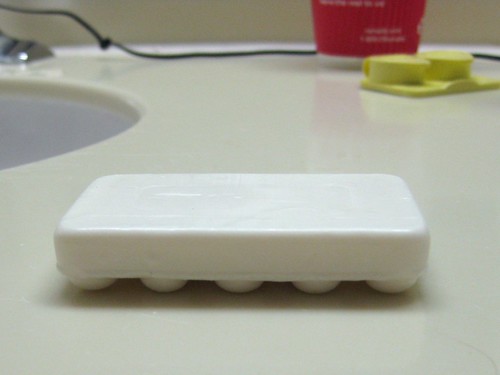 One of the standard progressions in electronics is to smaller and smaller packages for electronic devices. While this is wonderful in so many ways, it’s a pain in others. Many of our projects call for soldering components to a circuit board, where you have (for example) a microcontroller, some LED drivers and some LEDs. As miniaturization progresses, it has become harder to find big, easy to solder “through hole” versions of the LED driver chips that we like. We can be sure that eventually it will become difficult to find microcontrollers or even LEDs except in fine-pitch “surface mount” packages.
One of the standard progressions in electronics is to smaller and smaller packages for electronic devices. While this is wonderful in so many ways, it’s a pain in others. Many of our projects call for soldering components to a circuit board, where you have (for example) a microcontroller, some LED drivers and some LEDs. As miniaturization progresses, it has become harder to find big, easy to solder “through hole” versions of the LED driver chips that we like. We can be sure that eventually it will become difficult to find microcontrollers or even LEDs except in fine-pitch “surface mount” packages.
Many surface mount components are actually just fine for hand assembly with a soldering iron, or with a skillet or toaster oven, if you know what you’re doing.
But among the hardest of the packages to deal with– as in darn-near impossible for a hobbyist –is the Ball Grid Array, commonly referred to as BGA. BGAs can be any number of different integrated circuits — that don’t have leads on the sides, but instead have a grid of solder balls on the bottom. This allows for rather extreme miniaturization, since the whole package need not be much larger than the chip. The packages range from tiny logic gates, with only a few contacts, to great big CPUs and FPGAs with thousands of balls. Soldering these is not trivial, since every solder ball on the chip has to melt to the solder below on the circuit board, usually with the help of a specialized oven that pre-warms the bottom side of the board. Circuits with BGAs are usually inspected by X-ray, because it’s the only way to check all of those solder joints trapped under the chip.Given all that, you can imagine my surprise at coming across this BGA-packaged soap as a “bath bar” at a hotel. It’s well known that hotel bars of soap are small, but I never expected that they’d have to go to such extremes.




